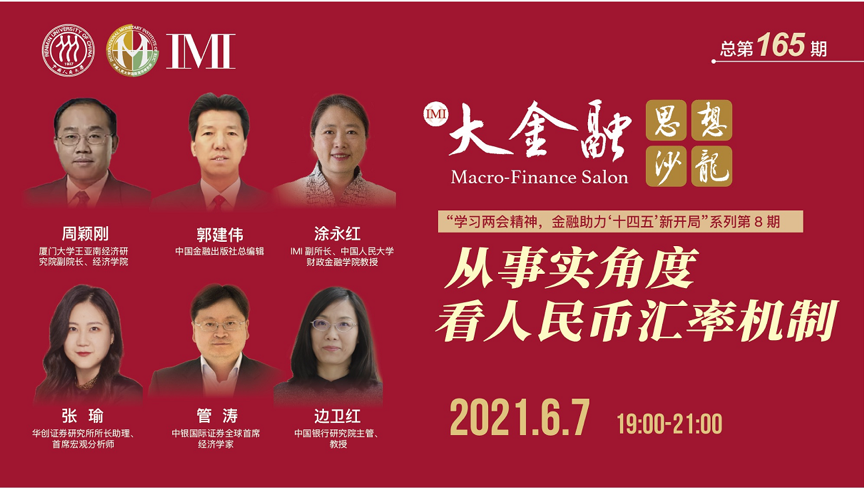Macro-Finance Salon (No. 165): RMB Exchange Rate Mechanism from a Factual Perspective
2021-06-07 IMI
On June 7, the online seminar of the 165th Macro-Finance Salon was jointly held by the International Monetary Institute (IMI) of Renmin University of China and the Department of Money and Finance of the School of Finance and Economics of Renmin University of China. Ms. Zhang Yu, Assistant to the Director and Chief Macro Analyst of Hua Chuang Securities Research Institute, gave a presentation titled “RMB Exchange Rate Mechanism from a Factual Perspective”. Mr. Guan Tao, Global Chief Economist of BOCI Securities; Mr. Guo Jianwei, Chief Editor of China Financial Publishing House; Mr. Zhou Yinggang, Vice President of Wang Yanan Institute of Studies in Economics and Professor of Department of Finance of the School of Economics, Xiamen University; and Mr. BianWeihong, Director of BOC Research Institute attended the seminar. The salon was presided over by Mr. Tu Yonghong, Deputy Director of the IMI and Professor of the School of Finance and Economics of Renmin University.
First, Ms. Zhang Yu gave the presentation on the report titled “View RMB Exchange Rate Mechanism from a Factual Perspective”, which pointed out that the exchange rate is the result of interest rates in the long run and is priced based on economic fundamentals. The reform of the exchange rate mechanism is also forced by economic fundamentals in the long term. At the long-term level, the report constructed an indicator model to forecast the 10-year Treasury interest rate of the U.S., and used China’s nominal industrial growth rate to replace the interest rates to make judgments. The report believes that the RMB has a certain possibility of depreciation in the medium-term perspective.
At the medium-term level, the report used the method of formula split and digitalization to illustrate the official expression — “managed floating exchange rate system based on market supply and demand, and adjusted by reference to a basket of currencies”. It suggests that the closing price reflecting market supply and demand is mostly transparent, and the foreign exchange movements maintaining the stability of the basket are absolutely transparent and cannot be manipulated. The countercyclical factor countering the malfunctioning of market supply and demand is not transparent and can only be reverse calculated afterwards.
The report argues that the internationalization of RMB still has a long way to go, and data proves that the exchange rate is not a tool to protect exports and defeat inflation. China’s medium- and long-term export competitiveness is stable and will not be affected by exchange rate fluctuations. Recent exchange rate fluctuations are mainly caused by the weakness of the dollar index in a short term, but the long-term dollar index has rebound momentum. The action of the Central Bank this round is to trade exchange rate flexibility for monetary policy independence, but the Bank retains a suppressive attitude toward the volatility expectations outside the RMB market. The safe space of a rebound of RMB’s appreciation against dollar is sufficient.
Later, the seminar discussed on issues including the impact of RMB appreciation on export enterprises, how to view the recent exchange rate performance and exchange rate mechanism, the multiple balance of financial cycles and exchange rates, and the trends of major currency exchange rates under the current complex international and domestic economic environment.
